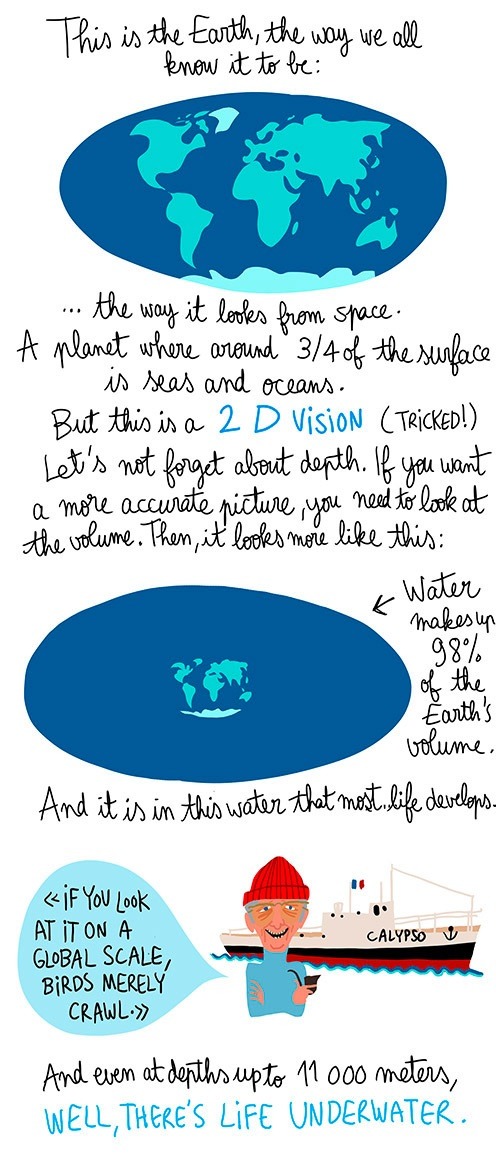Satomi’s Pygmy Seahorse (Hippocampus Satomiae) Is The Smallest Known Seahorse In The World With An

Satomi’s pygmy seahorse (Hippocampus satomiae) is the smallest known seahorse in the world with an average length of 13.8 millimeters. (via)
More Posts from Llamaslikesciencetoo and Others

DON’T GO IN THE WATER: NEW EVIDENCE THAT SOME DINOSAURS WERE STRONG SWIMMERS
Claw marks left on a river bottom in Sichuan, China are evidence for dinosaurs’ ability to swim relatively long distances. According to an international team of scientists in the journal Chinese Science Bulletin, theropod species of dinosaurs were able to travel in relatively deep bodies of water.
Keep reading

Fast-motion version {obviously}:

Source
How do you disentangle a humpback whale?
Very, very carefully – and without getting in the water. The Hawaiian Islands Large Whale Entanglement Response Network has it down to a science.

Photo: J. Moore/NOAA Permit #15240
Each year, numerous whales and other marine animals become entangled in a variety of materials, such as fishing gear, rope and plastic bags. Entanglement can physically harm animals while also impairing their movement. An entangled animal can find it difficult or impossible to feed, and at times the entanglement can drown them.
That’s where the Hawaiian Islands Large Whale Entanglement Response Network comes in. These highly-trained professionals from Hawaiian Islands Humpback Whale National Marine Sanctuary, working closely with and under authority of NOAA Fisheries’ Marine Mammal Health and Stranding Response Program, know how to safely rescue creatures like humpback whales from entanglement.

Humpback whales can hold their breath for much longer and swim faster than a human can, and an entangled whale is often stressed or panicked. Trying to free a 40-ton whale that likely doesn’t realize rescuers are there to help can be dangerous for the animal and for humans. Rescuers never enter the water to free an entangled whale.
Instead, rescuers grab hold of the entangled lines using a grappling hook, then attach a series of buoys to the lines. This keeps the whale at the surface and slows it down enough for the disentanglement team, following the whale in a small inflatable boat, to gain access to the animal and the lines it’s tangled in. However, even with the buoys attached, the inflatable boat may still get towed behind the animal. Humpback whales are strong animals that can move rapidly through the water, so this can be quite dangerous. It is important that the disentanglement team be trained and prepared to respond to the whale’s movements.

As the whale grows tired, the rescuers work their way closer. Once they’re close enough, they use a custom-designed knife attached to a long pole to cut away the gear entangling the whale. These knives are specially designed to cut the rope but not the whale. Typically, after several passes, the whale is free!
Once the whale is untangled, the team uses the grappling hook once again to collect and remove the debris from the water so that other animals don’t become trapped in the future.

Photo: Ed Lyman/NOAA, under NOAA permit #15240
Entanglement is a problem around the globe, and sanctuary staff can only help a small percentage of entangled whales. Since 2002, Hawaiian Islands Humpback Whale National Marine Sanctuary has received more than 100 confirmed reports of entangled humpbacks, representing at least 70 different animals — and more entanglements go unseen and unreported.
With that in mind, prevention is the ultimate objective: by reducing the amount of derelict fishing gear and other debris in the ocean and making actively fished gear more “whale safe,” we can reduce the number of whales and other animals that get entangled and hurt or killed.
Watch the Disentanglement Response Network in action:
GIFs via NOAA’s Marine Mammal Health and Stranding Response Program, under NOAA permits 932-1905, 15240 932-1489, and 932-1905-01/MA-009526-1, and Hawaii State Permit PMAL-2015-206.




The Japanese sawshark is a sawshark of the family Pristiophoridae, found in the northwest Pacific Ocean around Japan, Korea, and northern China. It has a flat snout, studded with teeth, which resembles a serrated saw. Protruding from the middle of the saw-like snout are two long, sensitive, whisker-like barbels. The sawshark uses these barbels, along with electro-receptors located on the underside of its saw (Ampullae of Lorenzini) to help it find prey buried in the sand as it cruises along the bottom of the ocean. [x]








Episode 46 of the In Defense of Plants Podcast has arrived!
This week its all about the flora of the Ozarks!
The Ozark Mountains have long been a mystery to me. This ancient mountain range is home to a bewildering diversity of plant life, some of which is found nowhere else in the world. From glades to woodlands and everything in between, the Ozarks have it all. Join me for a discussion with Justin Thomas, director of the Institute of Botanical Training. Justin and his wife have devoted their lives to studying and protecting the plants of this region. I learned a lot from talking with Justin and I know you will too.
Photos by Justin Thomas


It’s a cute little thing though.









DEEP-SEA BOTTOM TRAWLING IS KILLING OUR OCEANS
Originally posted at Penelope Bagieu’s blog
Customer: So seeing a whale is guaranteed, right?
Me: Well, it is the open ocean and they are wild animals so we cannot control when and where they are-
Customer: Yeah, but I’m paying to see a whale. How long until we see one?
Me:

Amazing, this is a crinoid swimming (edited after comments)

Scanning electron micrograph of a male and female flatworm. The smaller female can be seen emerging from the male’s gynecophoral canal. For their entire adult lives, females live inside the male. The gynecophoral canal can transfer nutrients and hormones between the male and female. Isn’t nature amazingly weird?
-
 forest-dreemurr liked this · 4 years ago
forest-dreemurr liked this · 4 years ago -
 completeandtotalchaos liked this · 5 years ago
completeandtotalchaos liked this · 5 years ago -
 goldrushrunning liked this · 5 years ago
goldrushrunning liked this · 5 years ago -
 skeletonjock reblogged this · 5 years ago
skeletonjock reblogged this · 5 years ago -
 skeletonjock liked this · 5 years ago
skeletonjock liked this · 5 years ago -
 littl3d0ll reblogged this · 5 years ago
littl3d0ll reblogged this · 5 years ago -
 littl3d0ll liked this · 5 years ago
littl3d0ll liked this · 5 years ago -
 phoofbingo liked this · 5 years ago
phoofbingo liked this · 5 years ago -
 goldrushrunning reblogged this · 5 years ago
goldrushrunning reblogged this · 5 years ago -
 adventurer12-07 liked this · 5 years ago
adventurer12-07 liked this · 5 years ago -
 solavina reblogged this · 5 years ago
solavina reblogged this · 5 years ago -
 luminescentworlds liked this · 5 years ago
luminescentworlds liked this · 5 years ago -
 typical-hipster liked this · 5 years ago
typical-hipster liked this · 5 years ago -
 sugarcoatedcricket liked this · 5 years ago
sugarcoatedcricket liked this · 5 years ago -
 supersciencegeek liked this · 5 years ago
supersciencegeek liked this · 5 years ago -
 herequeerandreadyfordeath liked this · 5 years ago
herequeerandreadyfordeath liked this · 5 years ago -
 memoriasinvisiveis liked this · 5 years ago
memoriasinvisiveis liked this · 5 years ago -
 clownishpossum reblogged this · 5 years ago
clownishpossum reblogged this · 5 years ago -
 clownishpossum liked this · 5 years ago
clownishpossum liked this · 5 years ago -
 weirdnaturalscience reblogged this · 5 years ago
weirdnaturalscience reblogged this · 5 years ago -
 vettechkat reblogged this · 6 years ago
vettechkat reblogged this · 6 years ago -
 ziio-love liked this · 6 years ago
ziio-love liked this · 6 years ago -
 mommajil-blog liked this · 7 years ago
mommajil-blog liked this · 7 years ago -
 bluupops liked this · 7 years ago
bluupops liked this · 7 years ago -
 usagitsuki reblogged this · 7 years ago
usagitsuki reblogged this · 7 years ago -
 emptyswimmingp00ls liked this · 7 years ago
emptyswimmingp00ls liked this · 7 years ago -
 sprinklesanz-blog liked this · 7 years ago
sprinklesanz-blog liked this · 7 years ago -
 stylistic-bullet liked this · 7 years ago
stylistic-bullet liked this · 7 years ago -
 dramaticcroissant reblogged this · 8 years ago
dramaticcroissant reblogged this · 8 years ago -
 ruby-ata-blog liked this · 8 years ago
ruby-ata-blog liked this · 8 years ago -
 marianaptv-blog liked this · 8 years ago
marianaptv-blog liked this · 8 years ago -
 jillibags reblogged this · 8 years ago
jillibags reblogged this · 8 years ago -
 jillibags liked this · 8 years ago
jillibags liked this · 8 years ago -
 hudderston liked this · 8 years ago
hudderston liked this · 8 years ago -
 okerti-blog liked this · 8 years ago
okerti-blog liked this · 8 years ago -
 firesymphony liked this · 8 years ago
firesymphony liked this · 8 years ago -
 threefacefish reblogged this · 8 years ago
threefacefish reblogged this · 8 years ago -
 lushandlovelies liked this · 8 years ago
lushandlovelies liked this · 8 years ago -
 qtkitty reblogged this · 8 years ago
qtkitty reblogged this · 8 years ago -
 madburnishjae liked this · 8 years ago
madburnishjae liked this · 8 years ago -
 f1rstperson reblogged this · 8 years ago
f1rstperson reblogged this · 8 years ago -
 deadblog17 reblogged this · 8 years ago
deadblog17 reblogged this · 8 years ago -
 warriorofdragonsinspiration reblogged this · 8 years ago
warriorofdragonsinspiration reblogged this · 8 years ago
Mainly interested in ecology, but also the entirety of science.
179 posts